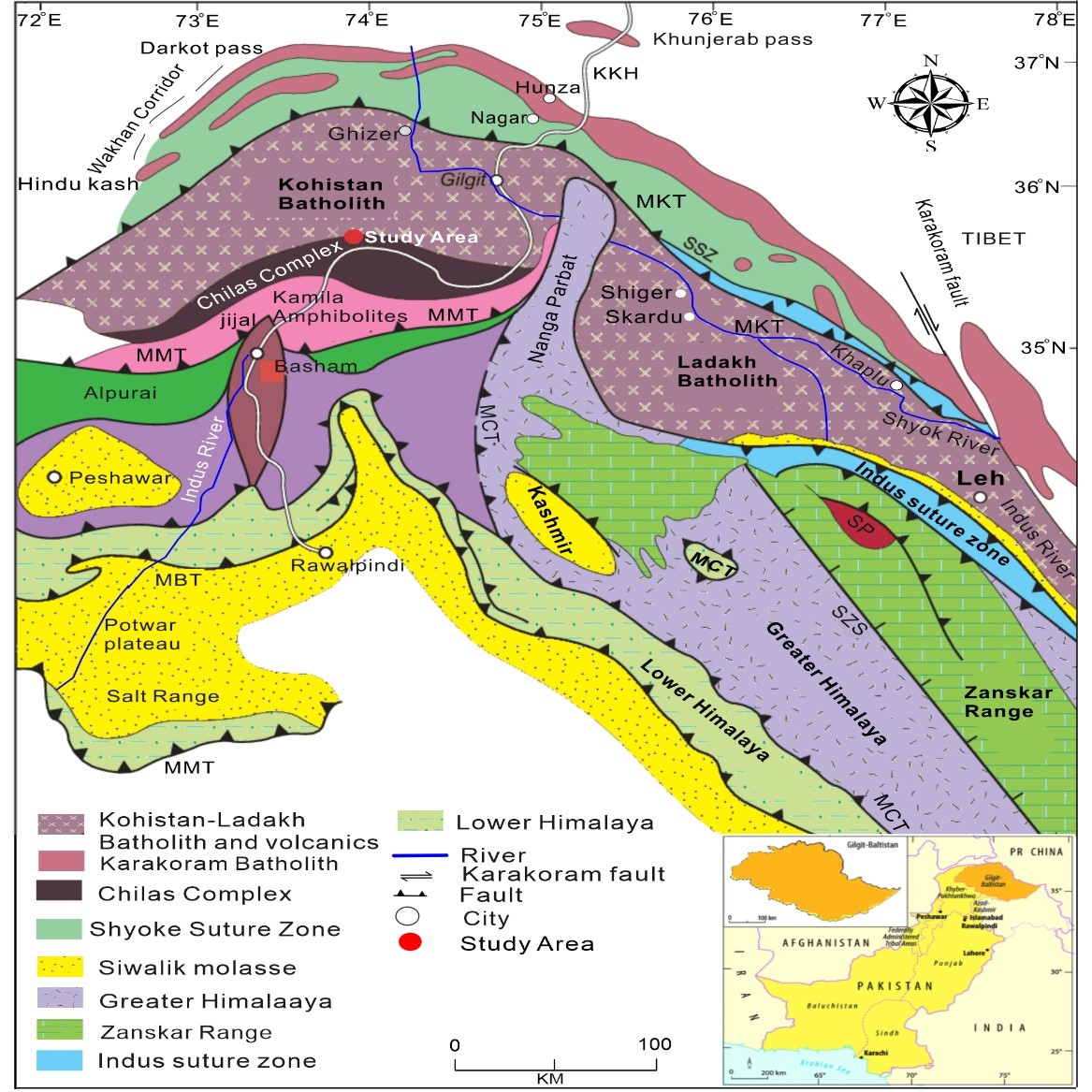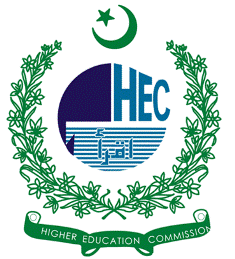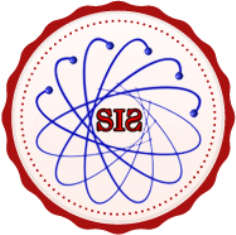Physio-Mechanical and Petrographic Characteristics of Granitic Rocks from the Demote Valley, Gilgit, Pakistan: Implications for Strength and Bearing Capacity
Keywords:
Granitic Rocks, Physio-Mechanical Properties, Petrography, Gilgit BaltistanAbstract
The granitic rocks of the Damote Valley (Juglote Group, Kohistan Batholith) were evaluated for their physio-mechanical and petrographic properties to assess their suitability for construction, particularly as dimension stones. Detailed petrography and tests such as Uniaxial Compressive Strength (UCS), Brazilian Tensile Strength (BTS), Ultrasonic Pulse Velocity (UPV), Schmidt Hammer, Specific Gravity, Porosity, Water Absorption, and Slake Durability were conducted. The granitic rocks, medium to coarse-grained with no preferred orientation, consist mainly of plagioclase (19–35%), quartz (30–43%), and alkali feldspar (40–44%), along with biotite, muscovite, sericite, and minor opaque minerals. Based on geographic location, the granites are divided into three zones: Fulkin granite (Zone 1), Bargin (Zone 2), and Shing (Zone 3). The average Uniaxial Compressive Strength (UCS) values of the granite from the Demote area are 63 MPa for Fulkin granite, 66 MPa for Bargain granite, and 53 MPa for Shing granite, reflecting the granite’s suitability for engineering applications. BTS values range from 7.55 to 12.04 MPa. Schmidt hammer rebound values range from 43 to 47, while specific gravity averages from 2.5 to 2.98. Water absorption is low (0.34–0.60%), and porosity ranges from 1.19% to 1.28%. All results fall within ASTM specifications. The medium-grained granite is stronger and more durable than coarse-grained varieties due to its tighter grain packing and fewer microcracks. Based on these findings, Damote granites are suitable for construction in roads, bridges, constructions, and the dimension stone in the area.
References
“(PDF) Tectonic subdivision of granitic rocks of north Pakistan.” Accessed: Dec. 31, 2024. [Online]. Available: https://www.researchgate.net/publication/299826081_Tectonic_subdivision_of_granitic_rocks_of_north_Pakistan
M. T. George, N. B. W. Harris, and R. W. H. Butler, “The tectonic implications of contrasting granite magmatism between the Kohistan island arc and the Nanga Parbat-Haramosh Massif, Pakistan Himalaya,” Geol. Soc. Spec. Publ., vol. 74, pp. 173–191, 1993, doi: 10.1144/GSL.SP.1993.074.01.13.
M. P. Coward, M. Q. Jan, D. Rex, J. Tarney, M. F. Thirlwall, and B. F. Windley, “Geo-tectonic framework of the Himalaya of N Pakistan.,” J. Geol. Soc. London., vol. 139, no. 3, pp. 299–308, 1982, doi: 10.1144/GSJGS.139.3.0299.
J. L. P. Zeitler, R. A. Khan Tahirkheli, C. Naeser, N. Johnson, “Preliminary Fission Track Ages from the Swat Valley, Northern Pakistan,” J. Himal. Earth Sci., vol. 13, no. 1, pp. 63–65, 1980, [Online]. Available: http://ojs.uop.edu.pk/jhes/article/view/1184
L. Ahmad, M. T. Shah, and S. D. Khan, “Reflectance spectroscopy and remote sensing data for finding sulfide-bearing alteration zones and mapping geology in Gilgit-Baltistan, Pakistan,” Earth Sci. Informatics, vol. 9, no. 1, pp. 113–121, Mar. 2016, doi: 10.1007/S12145-015-0239-X/METRICS.
I. Ahmed, M. Basharat, L. Sousa, and M. S. Mughal, “Evaluation of building and dimension stone using physico-mechanical and petrographic properties: a case study from the Kohistan and Ladakh batholith, Northern Pakistan,” Environ. Earth Sci., vol. 80, no. 22, pp. 1–17, Nov. 2021, doi: 10.1007/S12665-021-10007-Y/METRICS.
A. Hussain et al., “Chemical composition of gemstones and characterization of their host pegmatites and country rocks from Chumar Bakhoor, Gilgit-Baltistan, Pakistan: implications for the source of gem-forming fluids,” Arab. J. Geosci., vol. 14, no. 13, pp. 1–15, Jul. 2021, doi: 10.1007/S12517-021-07682-3/METRICS.
M. K. A. Maqpoon, R.J.H., K. Khurshid, “Gilgit-Baltistan. Population,” vol. 6, no. 7, p. 1,249,000, 2013, [Online]. Available: https://www.pc.gov.pk/uploads/report/MICS_GB_1617-downloaded.pdf
J. A. Qureshi et al., “Inventory and Quantitative Valuation of Geological and Geomorphological Sites from Gilgit-Baltistan, Northern Pakistan,” Geoheritage, vol. 13, no. 4, pp. 1–15, Dec. 2021, doi: 10.1007/S12371-021-00617-0/METRICS.
A. A. Q. Hannan Younis, Farooq Ahmad, Muhammad Anees, Atia Atiq, Nida Shakeel, Muhammad Adil, Khurram Mehboob, Abdulsalam M. Alhawsawi, Rashid Khan, Ahmed M. Khubrani and M. Ajaz, “Gamma radioactivity and Environmental radiation risks of Granitoids in Central and Western Gilgit-Baltistan, Himalayas, North Pakistan,” Results Phys., vol. 37, p. 105509, 2022, doi: https://doi.org/10.1016/j.rinp.2022.105509.
A. R. Asif, M. Sajid, W. Ahmed, and A. Nawaz, “Weathering effects on granitic rocks in North Pakistan: petrographic insights, strength classifications, and construction suitability,” Environ. Earth Sci., vol. 83, no. 11, pp. 1–28, May 2024, doi: 10.1007/S12665-024-11655-6/METRICS.
S. Mishra, A. Khetwal, and T. Chakraborty, “Physio-Mechanical Characterization of Rocks,” J. Test. Eval., vol. 49, no. 3, pp. 1976–1998, May 2021, doi: 10.1520/JTE20180955.
B. O. T. Zelealem Haftu , Nageswara Rao Cheepurupalli , , Yewuhalashet Fissha , Sri Chandrahas N, “Rock Mechanical Properties and Resource Potential of Dimensional Stone and Terrazzo in Tigray, Ethiopia: A Geological and Geomechanical Assessment,” Rock Mech. Lett., vol. 1, no. 1, p. 4, 2024, doi: https://doi.org/10.70425/rml.202401.4.
A. U. R. Syed Yasir Ali Shah, Dou Bin, Obaidullah , Javid Hussain, Khaleel Hussain, Ali Asghar, Hadi Hussain, “Physio-Mechanical Properties and Petrographic Analysis of NikanaiGhar Limestone KPK, Pakistan,” Open J. Civ. Eng., vol. 12, no. 2, pp. 169–188, 2022, doi: 10.4236/ojce.2022.122011.
M. B. Nadaf, V. Maralapalle, A. A. Zende, and A. I. A. Momin, “Mineralogical composition and strength characteristics of granite rocks,” Sadhana - Acad. Proc. Eng. Sci., vol. 49, no. 4, pp. 1–22, Dec. 2024, doi: 10.1007/S12046-024-02635-4/METRICS.
M. A. Alsaiari and A. A. El Aal, “Influence of composition on the physico-mechanical properties of granitic rocks used in floor covering and building cladding in Najran Region, Saudi Arabia,” Arab. J. Geosci., vol. 14, no. 20, pp. 1–18, Oct. 2021, doi: 10.1007/S12517-021-08387-3/METRICS.
“Evaluation of the durability of granite in architectural monuments - Google Search.” Accessed: Dec. 31, 2024. [Online]. Available: https://www.google.com/search?q=Evaluation+of+the+durability+of+granite+in+architectural+monuments&oq=Evaluation+of+the+durability+of+granite+in+architectural+monuments&gs_lcrp=EgZjaHJvbWUyBggAEEUYOdIBBzU5MWowajeoAgCwAgA&sourceid=chrome&ie=UTF-8
A. R. Mahdi Askaripour,Ali Saeidi ,Patrick Mercier-Langevin, “A Review of Relationship between Texture Characteristic and Mechanical Properties of RockNo Title,” Geol. Surv. Finland. Rep. Investig., vol. 2, no. 1, pp. 262–296, 2022, doi: https://doi.org/10.3390/geotechnics2010012.
M. H. B. Nasseri and B. Mohanty, “Fracture toughness anisotropy in granitic rocks,” Int. J. Rock Mech. Min. Sci., vol. 45, no. 2, pp. 167–193, Feb. 2008, doi: 10.1016/J.IJRMMS.2007.04.005.
“(PDF) Petrography and physico-mechanical properties of the granitic rocks from Kumrat valley, Kohistan Batholith, NW Pakistan.” Accessed: Dec. 31, 2024. [Online]. Available: https://www.researchgate.net/publication/275352897_Petrography_and_physico-mechanical_properties_of_the_granitic_rocks_from_Kumrat_valley_Kohistan_Batholith_NW_Pakistan
M. P. Searle, “Geological evidence against large-scale pre-Holocene offsets along the Karakoram Fault: Implications for the limited extrusion of the Tibetan plateau,” Tectonics, vol. 15, no. 1, pp. 171–186, Feb. 1996, doi: 10.1029/95TC01693.
P. J. Treloar and C. N. Izatt, “Tectonics of the Himalayan collision between the Indian Plate and the Afghan Block: A synthesis,” Geol. Soc. Spec. Publ., vol. 74, pp. 69–87, 1993, doi: 10.1144/GSL.SP.1993.074.01.06.
M. Q. J. M. P. Searle, M. Asif Khan, J. E. Fraser, S. J. Gough, “The tectonic evolution of the Kohistan-Karakoram collision belt along the Karakoram Highway transect, north Pakistan,” Tectonics, vol. 18, no. 6, pp. 929–949, 1999, doi: https://doi.org/10.1029/1999TC900042.
M. G. Petterson and P. J. Treloar, “Volcanostratigraphy of arc volcanic sequences in the Kohistan arc, North Pakistan: volcanism within island arc, back-arc-basin, and intra-continental tectonic settings,” J. Volcanol. Geotherm. Res., vol. 130, no. 1–2, pp. 147–178, Feb. 2004, doi: 10.1016/S0377-0273(03)00287-7.
M. T. Shah and J. W. Shervais, “The Dir-Utror metavolcanic sequence, Kohistan arc terrane, northern Pakistan,” J. Asian Earth Sci., vol. 17, no. 4, pp. 459–475, Aug. 1999, doi: 10.1016/S1367-9120(99)00009-7.
P. J. Treloar, M. G. Petterson, M. Q. Jan, and M. A. Sullivan, “A re-evaluation of the stratigraphy and evolution of the Kohistan arc sequence, Pakistan Himalaya: Implications for magmatic and tectonic arc-building processes,” J. Geol. Soc. London., vol. 153, no. 5, pp. 681–693, Sep. 1996, doi: 10.1144/GSJGS.153.5.0681.
J. V. M. A. Pêcher, L. Seeber, S. Guillot, F. Jouanne, A. Kausar, M. Latif, A. Majid, G. Mahéo, J. L. Mugnier, Y. Rolland, P. van der Beek, “Stress field evolution in the northwest Himalayan syntaxis, northern Pakistan,” Tectonics, vol. 27, no. 6, 2008, doi: https://doi.org/10.1029/2007TC002252.
J. Ameratunga, N. Sivakugan, and B. M. Das, “Laboratory Rock Tests,” pp. 207–223, 2016, doi: 10.1007/978-81-322-2629-1_9.
A. Aydin, “ISRM Suggested Method for Determination of the Schmidt Hammer Rebound Hardness: Revised Version,” ISRM Suggest. Methods Rock Charact. Test. Monit. 2007-2014, pp. 25–33, 2008, doi: 10.1007/978-3-319-07713-0_2.
M. J. Le Bas and A. L. Streckeisen, “The IUGS systematics of igneous rocks,” J. Geol. Soc. London., vol. 148, no. 5, pp. 825–833, 1991, doi: 10.1144/GSJGS.148.5.0825.
M. Inoue and M. Ohomi, “Relation Between Uniaxial Compressive Strength And Elastic Wave Velocity of Soft Rock.” OnePetro, Sep. 21, 1981. Accessed: Dec. 31, 2024. [Online]. Available: https://dx.doi.org/
B. H. G. Brady and E. T. Brown, “Rock Mechanics for underground mining: Third edition,” Rock Mech. Undergr. Min. Third Ed., pp. 1–628, 2006, doi: 10.1007/978-1-4020-2116-9/COVER.
A. Farhadian, E. Ghasemi, S. H. Hoseinie, and R. Bagherpour, “Prediction of Rock Abrasivity Index (RAI) and Uniaxial Compressive Strength (UCS) of Granite Building Stones Using Nondestructive Tests,” Geotech. Geol. Eng., vol. 40, no. 6, pp. 3343–3356, Jun. 2022, doi: 10.1007/S10706-022-02095-9/METRICS.

Downloads
Published
How to Cite
Issue
Section
License
Copyright (c) 2024 50Sea

This work is licensed under a Creative Commons Attribution 4.0 International License.




















